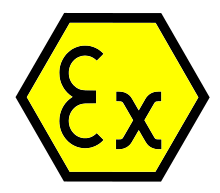ATEX directive
The ATEX directive consists of two EU directives describing what equipment and work environment is allowed in an environment with an explosive atmosphere. ATEX derives its name from the French title of the 94/9/EC directive: Appareils destinés à être utilisés en ATmosphères EXplosibles.
Directives


As of July 2003, organizations in EU must follow the directives to protect employees from explosion risk in areas with an explosive atmosphere.
There are two ATEX directives (one for the manufacturer and one for the user of the equipment):
- the ATEX 95 equipment directive 94/9/EC, Equipment and protective systems intended for use in potentially explosive atmospheres;
- the ATEX 137 workplace directive 99/92/EC, Minimum requirements for improving the safety and health protection of workers potentially at risk from explosive atmospheres.
The ATEX 94/9/EU that is dedicated to the manufacturer has changed. Still applicable up to 19 April 2016 the ATEX 94/9/EC will be removed and replaced by a new directive.
This new ATEX directive was published on Saturday 29 March 2014, under the new reference : Directive 2014/34/EU of the European Parliament and of the Council of 26 February 2014 on the harmonisation of the laws of the Member States relating to equipment and protective systems intended for use in potentially explosive atmospheres (recast) Text with EEA relevance - Official Journal of the European Union L 96 from 29/03/2014.
This new ATEX directive 2014/34/EU will be mandatory for manufacturer on 20 April 2016 as is stated in article 44 of the directive.
Promised for a long time, this new ATEX directive has been published together with 8 other directives in the frame of NEW LEGISLATIVE FRAMEWORK (NLF) ALIGNMENT PACKAGE (Implementation of the Goods Package). It was the subject of a "COMMUNICATION FROM THE COMMISSION TO THE EUROPEAN PARLIAMENT AND THE COUNCIL" for the Alignment of ten technical harmonisation directives to Decision No 768/2008/EC of the European Parliament and of the Council of 9 July 2008 on a common framework for the marketing of products, in Brussels, 21.11.2011 under reference COM(2011) 763 final.
This texts aims to align at its origin 10 directives who were :
- Civil Explosives Directive: Directive 93/15/EEC on the harmonisation of the provisions relating to the placing on the market and supervision of explosives for civil use;
- Directive on equipment for use in explosive atmospheres (ATEX): Directive 94/9/EC on the approximation of the laws of the Member States concerning equipment and protective systems intended for use in potentially explosive atmospheres;
- Lifts Directive: Directive 95/16/EC on the approximation of the laws of the Member States relating to lifts;
- Pressure Equipment Directive: Directive 97/23/EC on the approximation of the laws of the Member States concerning pressure equipment;
- Measuring Instruments Directive: Directive 2004/22/EC on measuring instruments;
- Electromagnetic Compatibility Directive (EMC): Directive 2004/108/EC on the approximation of the laws of the Member States relating to electromagnetic compatibility;
- Low Voltage Directive (LVD): Directive 2006/95/EC on the harmonisation of the laws of Member States relating to electrical equipment designed for use within certain voltage limits;
- Pyrotechnic Articles Directive: Directive 2007/23/EC on the placing on the market of pyrotechnic articles;
- Non-automatic Weighing Instruments Directive: Directive 2009/23/EC on non-automatic weighing instruments;
- Simple Pressure Vessels Directive: Directive 2009/105/EC relating to simple pressure vessels
The text of the new ATEX 2014/34/EU in available on the following web site :
Regarding ATEX 99/92/EC directive, the requirement is that Employers must classify areas where hazardous explosive atmospheres may occur into zones. The classification given to a particular zone, and its size and location, depends on the likelihood of an explosive atmosphere occurring and its persistence if it does.
Areas classified into zones (0, 1, 2 for gas-vapor-mist and 20, 21, 22 for dust) must be protected from effective sources of ignition.[1] Equipment and protective systems intended to be used in zoned areas must meet the requirements of the directive. Zone 0 and 20 require Category 1 marked equipment, zone 1 and 21 require Category 2 marked equipment and zone 2 and 22 require Category 3 marked equipment. Zone 0 and 20 are the zones with the highest risk of an explosive atmosphere being present.[1]
Equipment in use before July 2003 is allowed to be used indefinitely provided a risk assessment shows it is safe to do so.
The aim of directive 94/9/EC is to allow the free trade of ‘ATEX’ equipment and protective systems within the EU by removing the need for separate testing and documentation for each member state.
The regulations apply to all equipment intended for use in explosive atmospheres, whether electrical or mechanical, including protective systems. There are two categories of equipment 'I' for mining and 'II' for surface industries. Manufacturers who apply its provisions and affix the CE marking and the Ex marking are able to sell their equipment anywhere within the European union without any further requirements with respect to the risks covered being applied. The directive covers a large range of equipment, potentially including equipment used on fixed offshore platforms, in petrochemical plants, mines, flour mills and other areas where a potentially explosive atmosphere may be present.
In very broad terms, there are three preconditions for the directive to apply: the equipment a) must have its own effective source of ignition; b) be intended for use in a potentially explosive atmosphere (air mixtures); and c) be under normal atmospheric conditions.
The directive also covers components essential for the safe use and safety devices directly contributing to the safe use of the equipment in scope. These latter devices may be outside the potentially explosive environment.
Manufacturers/suppliers (or importers, if the manufacturers are outside the EU) must ensure that their products meet essential health and safety requirements and undergo appropriate conformity procedures. This usually involves testing and certification by a ‘third-party’ certification body (known as a Notified Body e.g. Intertek, Sira, Baseefa, Lloyd's, TUV ICQC) but manufacturers/suppliers can ‘self-certify’ Category 3 equipment (technical dossier including drawings, hazard analysis and users manual in the local language) and Category 2 non-electrical equipment but for Category 2 the technical dossier must be lodged with a notified body. Once certified, the equipment is marked by the ‘CE’ (meaning it complies with ATEX and all other relevant directives) and ‘Ex’ symbol to identify it as approved under the ATEX directive. The technical dossier must be kept for a period of 10 years.
Certification ensures that the equipment or protective system is fit for its intended purpose and that adequate information is supplied with it to ensure that it can be used safely. There are four ATEX classification to ensure that a specific piece of equipment or protective system is appropriate and can be safely used in a particular application: 1. Industrial or Mining Application; 2. Equipment Category; 3. Atmosphere; and 4. Temperature.
The ATEX as an EU directive finds its US equivalent under the HAZLOC standard. This standard given by the Occupational Safety and Health Administration defines and classifies hazardous locations such as explosive atmospheres.
Technical definitions
In DSEAR, an explosive atmosphere is defined as a mixture of dangerous substances with air, under atmospheric conditions, in the form of gases, vapours, mist or dust in which, after ignition has occurred, combustion spreads to the entire unburned mixture.
Atmospheric conditions are commonly referred to as ambient temperatures and pressures. That is to say temperatures of –20 °C to 40 °C and pressures of 0.8 to 1.1 bar.[2]
Zone classification
Zone 0 - A place in which an explosive atmosphere consisting of a mixture with air of dangerous substances in the form of gas, vapor or mist is present continuously or for long periods or frequently
Zone 1 - A place in which an explosive atmosphere consisting of a mixture with air of dangerous substances in the form of gas, vapor or mist is likely to occur in normal operation occasionally.
Zone 2 - A place in which an explosive atmosphere consisting of a mixture with air of dangerous substances in the form of gas, vapor or mist is not likely to occur in normal operation but, if it does occur, will persist for a short period only.
Hazard - Dusts
Zone 20 - A place in which an explosive atmosphere in the form of a cloud of combustible dust in air is present continuously, or for long periods or frequently.
Zone 21 - A place in which an explosive atmosphere in the form of a cloud of combustible dust in air is likely to occur in normal operation occasionally.
Zone 22 - A place in which an explosive atmosphere in the form or a cloud of combustible dust in air is not likely to occur in normal operation but, if it does occur, will persist for a short period only.
- Effective ignition source
Effective ignition source is a term defined in the European ATEX directive as an event which, in combination with sufficient oxygen and fuel in gas, mist, vapor or dust form, can cause an explosion. Methane, hydrogen or coal dust are examples of possible fuels.[3]
Effective ignition sources are:
- Lightning strikes.
- Open flames. This varies from a lit cigarette to welding activity.
- Mechanically generated impact sparks. For example, a hammer blow on a rusty steel surface compared to a hammer blow on a flint stone. The speed and impact angle (between surface and hammer) are important; a 90 degree blow on a surface is relatively harmless.
- Mechanically generated friction sparks. The combination of materials and speed determine the effectiveness of the ignition source. For example, 4.5 m/s steel-steel friction with a force greater than 2 kN is an effective ignition source. The combination of aluminium and rust is also notoriously dangerous. More than one red hot spark is often necessary in order to have an effective ignition source.
- Electric sparks. For example, a bad electrical connection or a faulty pressure transmitter. The electric energy content of the spark determines the effectiveness of the ignition source.
- High surface temperature. This can be the result of milling, grinding, rubbing, mechanical friction in a stuffing box or bearing, or a hot liquid pumped into a vessel. For example, the tip of a lathe cutting tool can easily be 600 Celsius (1100 °F); a high pressure steam pipe may be above the autoignition temperature of some fuel/air mixtures.
- Electrostatic discharge. Static electricity can be generated by air sliding over a wing, or a non-conductive liquid flowing through a filter screen.
- Radiation.
- Adiabatic compression. Air is pumped into a vessel and the vessel surface heats up.
See also
- Electrical equipment in hazardous areas
- DSEAR (UK implementation of ATEX 137)
References
- 1 2 "Explosive Atmospheres - classification of hazardous areas (zoning) and selection of equipment" (PDF). HSE UK.
- ↑ "ATEX and explosive atmospheres". HSE UK.
- ↑ Michelis, J.: "Explosionsschutz im Bergbau unter Tage", Verlag Glückauf Essen, 1998, ISBN 3-7739-0900-4
External links
- Directive 1999/92/EC
- ATEX Guidelines (First edition - April 2016)
- Intrinsic Safety Regulations
- ATEX new directive from EUROPA